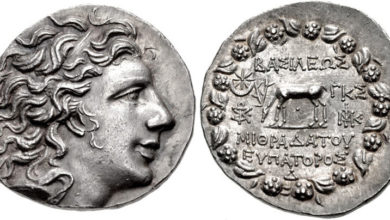On this day in 1585: the Treaty of Nemours

On this day in 1585, the Treaty of Nemours is signed between Catherine de’ Medici (Queen Mother of France), acting for the king, and representatives of the House of Guise. This treaty abolished earlier edicts of tolerance, and is widely considered as a renewal of the old French Wars of Religion.
BACKGROUND TO THE RELIGIOUS WARS
When Henry II (r. 1547 – 1559) died accidentally during a tournament in 1559, his sickly fifteen-year-old son, Francis II (d. 1560) came to the throne under the regency of the queen mother, Catherine de’ Medici. With the monarchy so weakened, three powerful families began to compete to control France.

They were the Bourbons, whose power lay in the south and west, the Montmorency-Châtillons, who controlled the center of France; and the Guises, who were dominant in eastern France. The Guises were by far the strongest, and the name of “Guise” was interchangeable with militant, ultra-Catholicism.
The Bourbon and Montmorency-Châtillon families, in contrast, developed strong Huguenot sympathies, largely for political reasons (French Protestants were called Huguenots after Besancon Hughes, the leader of Geneva’s political revolt against the Savoyards in the late 1520s.) The Bourbon Louis I, prince of Condé (d. 1569), and the Montmorency-Châtillon admiral Gaspard de Coligny (1519 – 1572) became the political leaders of the French Protestant movement. Often for quite different reasons, ambitious aristocrats and discontented townspeople joined Calvinist churches in opposition to the Guise-dominated French monarchy.

In 1561 over 2000 Huguenot congregations existed throughout France. Although they made up only about 1/15 of the population, Huguenots held important geographic areas and represented the more powerful segments of French society. Over 2/5 of the French aristocracy became Huguenots. Many apparently hoped to establish within France a principle of territorial sovereignty akin to that secured within the Holy Roman Empire by the Peace of Augsburg (1555), and thus, Calvinism indirectly served the forces of political decentralization.
Following Francis II’s death in 1560, Catherine de’ Medici continued as regent for the second son, Charles IX (r. 1560 – 1574). Fearing the Guises, Catherine, whose first concern was always to preserve the monarchy, sought allies among the Protestants. Early in 1562 she granted Protestants freedom to worship publicly outside towns – although only privately within them – and to hold synods, or church assemblies.

A FIRE STARTED
In March of that same year this royal toleration ended when the Duke of Guise surprised a Protestant congregation worshipping illegally at Vassy in Champagne and proceeded to massacre many of the Protestants – an event that marked the beginning of the French Wars of Religion.
Perpetually caught between fanatical Huguenot and Guise extremes, Queen Catherine always sought to play the one side against the other. She wanted a Catholic France but not a Guise-dominated monarchy. On August 22, 1572, four days after the Huguenot Henry of Navarre married Charles IX’s sister (Margaret of Valois) – another sign of growing Protestant power in the queen mother’s eye – the Huguenot leader Coligny was wounded by an assassin’s bullet.
Catherine had apparently been a part of this Guise plot to eliminate Coligny. After its failure, she feared both the king’s reaction and the Huguenot response under a recovered Coligny, therefor she convinced king Charles that a Huguenot coup was afoot, inspired by Coligny and that only the swift execution of the Huguenot leaders could save the crown from a Protestant attack.
This led to the infamous St. Bartholomew’s Day Massacre, on August 24, where en estimated 3000 Huguenots were butchered in Paris, and around 20 000 more Huguenots would die over the coming days in coordinated attacks throughout France. This event changed the nature of the struggle between Protestants and Catholics both within and beyond the borders of France.

It was thereafter no longer an internal contest between Guise and Bourbon factions for French political influence, nor was it simply a Huguenot campaign to win basic religious freedoms. Henceforth, in Protestant eyes, it became an international struggle to the death for sheer survival against an adversary whose cruelty justified any means of resistance.
Henry III (r. 1574 – 1589, the third son of Henry II and the last Valois king) rose to the throne in 1574, and quickly discovered that the monarchy was wedged between a radical Catholic League, formed in 1576 by Henry of Guise, and vengeful Huguenots. Like the queen mother, Henry III sought to steer a middle course, and in his effort he received support from a growing body of neutral Catholics and Huguenots who put the political survival of France above its religious unity.
THE TREATY OF NEMOURS
Such “politiques” as they were called, were prepared to compromise religious creeds to save the nation. Since Henry III was childless and likely to remain so, the legitimate successor to the throne of France was the king’s distant cousin and chief of the Protestant party, Henry, king of Navarre.
In an attempt to gain control of the Catholic League, headed by members of the house of Guise and supported by Spain, Henry III declared himself its chief, an act that forced him to break with Henry of Navarre. He did so with the Treaty of Nemours, which cancelled all previous edicts, dismissed all Huguenots from official office, but it also forced the king to capitulate to the demands of the Catholic League, and it would eventually lead to the final stage of the French Wars of Religion, the so-called “War of the Three Henries”, which ended with Henry of Navarre outliving both Henry III and the Guise Henry, and he became Henry IV of France.
In the mid-1580s the Catholic League became dominant in Paris. Henry III failed to rout the league with a surprise attack in 1588 and had to flee Paris. Forced by his weakened position into guerrilla tactics, the king had both the Duke and the Cardinal of Guise assassinated. The Catholic League reacted with a fury that matched the earlier Huguenot response to the Massacre of Saint Bartholomew’s Day. The king was now forced to strike an alliance with his Protestant cousin and heir, Henry of Navarre, in April 1589.
As the two Henrys prepared to attack Paris, however, a fanatical Dominican friar murdered Henry III. Thereupon the Bourbon Huguenot Henry of Navarre became Henry IV of France (r. 1589 – 1610). Henry IV came to the throne as a “politique”, weary of religious strife and prepared to place political peace above a majority Catholic France.






